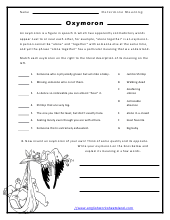Advanced Similes and Metaphors- Both of these forms of language strive to create a clear and vivid comparison the difference between the two is that similes always incorporate the use of the words "as" or "like".
Alliteration- This is when you have two words that are placed next to each other and they begin with the same or similar sounds. It results in a silly sound.
Allusion- This is a way to bring something up very subtly in an indirect manner. It is often used to reference things the author earlier disclosed.
Assonance- This is when you repeat a vowel through nearby words. This creates somewhat of an echo sound and makes for a cool language use.
Buzzwords- You will found these used in the business world frequently. They are often used to add a flare of sophistication.
Cliches- Cliches are mostly culture specific. They can often be way overused sayings that will over time tend to annoy people.
Conveying Ideas with Words and Phrases- Timing with words and phrases is often the key to getting your thoughts across in an impactful way.
Explaining Common Idioms, Adages, and Proverbs- Adages are well known proverbs that have been handed down from generation to generation. Idioms are nonliteral expressions that are culture focused. Proverbs are statements of wisdom that are put in simple terms.
Explaining Similes and Metaphors- Being able to explain a comparison is a huge skill for students to master.
Figurative, Connotative, and Technical Word Meanings- Words can have differing meanings based on the context and setting they are used in.
Figures of Speech- When we are trying to form a vivid sense, for readers, we will use sayings that are not to be taken literally.
Hyperbole- This is when an author puts in an almost nuclear form of an exaggeration. It is often meant to add humor to any work.
Idioms, Adages, and Proverbs- The tasks here help students learn to write and use the work of others. These are all relatively common sayings that are subtly different.
Imagery- Authors will often use language that will tap into the human senses of their readers. This helps them establish emotional connections to pieces.
Interpreting Figurative Language- This is a very subjective section that requires a good bit of deep thought. They may mean slightly different things to others.
Irony and Puns- Puns are often jokes or wordplays that lend themselves to a verb form. Irony are a form of language that often means the opposite of what is stated.
Literal and Nonliteral Meanings of Word and Phrases- When a word of phrase is to be taken literally, it should follow its exact definition. Nonliteral words and phrases are complete exaggerations.
Literary Devices- These are techniques that authors use to help their audience connect with their work. There are so many different forms of this that we are literally adding an entire new section each month that falls under this.
Literary Terms- There are different techniques that writers include to get their works to stick out a little more.
Metaphors- The old faithful comparison throughout time. They are used to describe an action or object in a way that is not meant to be taken literally.
Onomatopoeia- These are words that sound exactly like what they are describing. You will find them commonly to communicate animal sounds.
Oxymorons- These terms can he so hilarious when used properly and add a sense of comedy to just about any work.
Personification- When we try to make something seem more human. This can be a great way to help people relate to what ever it is.
Platitude- This type of language does have a purpose although most people do not think so.
Similes- These comparisons always include the words "as" or "like". They are often confused with metaphors, but if you see those two words it is not.
Symbolism- When we represent one thing for another. The Ying and Yang is used to symbolize a balance that we should all strive for.
Using Descriptive and Sensory Language in Writing- Being able to share as much as possible is huge. The more effort you put into it, the great your readers will connect to your work.
Using Words and Phrases For Effect- When you want to stress something. This technique can engage readers and keep them interested in your work.
Word Meanings From Context Phrases- You can often determine the intent of phrase from the context that surrounds it.
Get FREE English Worksheets In Your Email
